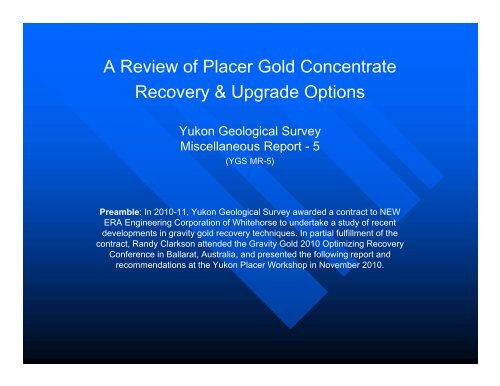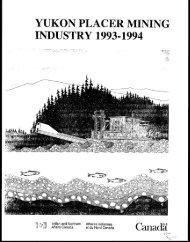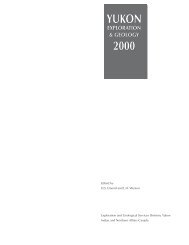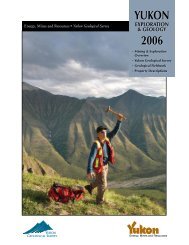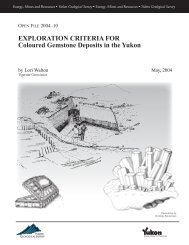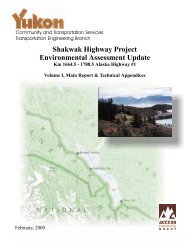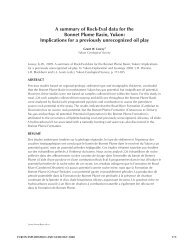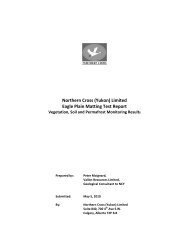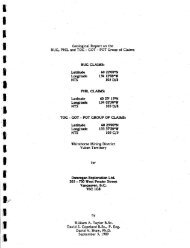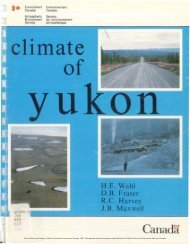NEW ERA Engineering Corporation
NEW ERA Engineering Corporation
NEW ERA Engineering Corporation
Create successful ePaper yourself
Turn your PDF publications into a flip-book with our unique Google optimized e-Paper software.
A Review of Placer Gold Concentrate<br />
Recovery & Upgrade Options<br />
Yukon Geological Survey<br />
Miscellaneous Report - 5<br />
(YGS MR-5)<br />
Preamble: In 2010-11, Yukon Geological Survey awarded a contract to <strong>NEW</strong><br />
<strong>ERA</strong> <strong>Engineering</strong> <strong>Corporation</strong> of Whitehorse to undertake a study of recent<br />
developments in gravity gold recovery techniques. In partial fulfillment of the<br />
contract, Randy Clarkson attended the Gravity Gold 2010 Optimizing Recovery<br />
Conference in Ballarat, Australia, and presented the following report and<br />
recommendations at the Yukon Placer Workshop in November 2010.
A Review of Placer Gold Concentrate<br />
Recovery & Upgrade Options<br />
Yukon Placer Forum<br />
By: Randy Clarkson, P.Eng. - November, 2010<br />
<strong>NEW</strong> <strong>ERA</strong> <strong>Engineering</strong> <strong>Corporation</strong>
About the Author<br />
Professional mining engineer working out of<br />
Whitehorse since 1980 on placer, lode mining and<br />
small hydro projects<br />
Developed innovative technique using<br />
Radiotracers to assess the real efficiency of<br />
various gold recovery and sampling systems<br />
World Authority regarding Placer Gold Mining<br />
and Gravity Gold Recovery<br />
Author of several publications on placer<br />
exploration, sampling, gold recovery and alluvial<br />
mining technology<br />
<strong>NEW</strong> <strong>ERA</strong> <strong>Engineering</strong> <strong>Corporation</strong>
Gravity Recovery in Lode Gold Operations<br />
Gravity pre-concentration<br />
in lode gold ores was<br />
common prior to 1960’s<br />
Used mineral jigs, pinched<br />
sluices, riffled drums and<br />
tables<br />
Generally located at<br />
grinding mill discharge<br />
Fell out of favor with<br />
improvements in froth<br />
flotation and cyanide<br />
leaching<br />
Considered to be out-ofdate<br />
technology<br />
Concerns over security of<br />
concentrates<br />
<strong>NEW</strong> <strong>ERA</strong> <strong>Engineering</strong> <strong>Corporation</strong>
Rebirth of Gravity in Lode Gold 1980’s<br />
High losses of coarse gold in traps<br />
in milling circuits – security<br />
concerns<br />
Limited residence time in CN- leach<br />
circuits to dissolve coarse particles<br />
Losses of coarse gold in flotation circuits<br />
Faster pay back on gold dore bar<br />
Less expensive than most other methods<br />
<strong>NEW</strong> <strong>ERA</strong> <strong>Engineering</strong> <strong>Corporation</strong>
Rebirth of Gravity in Lode Gold 1980’s<br />
Facilitated by the invention and promotion of the<br />
Knelson and Falcon centrifugal batch concentrators<br />
<strong>NEW</strong> <strong>ERA</strong> <strong>Engineering</strong> <strong>Corporation</strong>
Knelson or Falcon<br />
centrifugal concentrators<br />
installed in one of the<br />
many cyclone underflow<br />
streams<br />
Issues with addition of<br />
clean water to water jacket<br />
– upset water balance<br />
Reduced but continuing<br />
issues with gold lock up<br />
As only part of cyclone U/F<br />
is treated at one time<br />
Typical 1980 Installation<br />
<strong>NEW</strong> <strong>ERA</strong> <strong>Engineering</strong> <strong>Corporation</strong>
Typical 1980 Installation<br />
Need to upgrade these<br />
concentrates<br />
Generally with shaking tables<br />
Then smelting to dore bar<br />
Table tailings to CN or<br />
flotation<br />
Generally only 20-30% of<br />
gross (free) gold recovered<br />
by gravity<br />
<strong>NEW</strong> <strong>ERA</strong> <strong>Engineering</strong> <strong>Corporation</strong>
Gravity Recoverable Gold<br />
Test process developed by late Professor Andre<br />
Laplante at McGill University<br />
Samples were concentrated on lab scale Knelson<br />
concentrator and resulting concentrates were fire<br />
assayed<br />
Allowed the determination of gross gravity recoverable<br />
gold<br />
Often some of this gold was locked in sulphides<br />
Could not be upgradeable sufficiently with gravity<br />
methods<br />
<strong>NEW</strong> <strong>ERA</strong> <strong>Engineering</strong> <strong>Corporation</strong>
Continuous Discharge Concentrators<br />
Knelson and Falcon adapt/develop continuous<br />
discharge centrifugal concentrators<br />
<strong>NEW</strong> <strong>ERA</strong> <strong>Engineering</strong> <strong>Corporation</strong>
Other Continuous Discharge<br />
Kelsey centrifugal jig<br />
Pulsing action, water injection<br />
and ragging<br />
2 models 10 & 60 tph<br />
<strong>NEW</strong> <strong>ERA</strong> <strong>Engineering</strong> <strong>Corporation</strong>
Kelsey Centrifugal Jig<br />
Expensive to buy and complex to operate<br />
All feed must be finer than internal screen<br />
All tailings screened to recover ragging as oversize<br />
Regular lubrication and tuning of internal parts<br />
<strong>NEW</strong> <strong>ERA</strong> <strong>Engineering</strong> <strong>Corporation</strong>
Gekko InLine Pressure Jig<br />
Sealed unit operates under pressure<br />
Requires pressure locks on feed and<br />
on discharge of concentrate and<br />
tailings<br />
<strong>NEW</strong> <strong>ERA</strong> <strong>Engineering</strong> <strong>Corporation</strong>
Gekko InLine Pressure Jig<br />
10:1 concentration ratio 90%<br />
Similar recoveries as<br />
conventional jigs<br />
Much more expensive than<br />
conventional jigs<br />
<strong>NEW</strong> <strong>ERA</strong> <strong>Engineering</strong> <strong>Corporation</strong>
Continuous Gravity Concentrators<br />
Originally designed for other applications<br />
than gold<br />
All have low concentration ratios 10:1<br />
Created large volumes of concentrates<br />
with locked gold in sulphide minerals<br />
Development of intensive leach reactors<br />
to treat the locked gold concentrates<br />
Move away from gravity upgrading<br />
<strong>NEW</strong> <strong>ERA</strong> <strong>Engineering</strong> <strong>Corporation</strong>
Intensive Leach Reactors<br />
Fast Leach Kinetics due to continuous contact with high<br />
concentrations of CN and oxidant<br />
Used for free and sulphide locked gold<br />
Coupled with electro-winning or carbon absorption to<br />
remove gold from pregnant solution<br />
<strong>NEW</strong> <strong>ERA</strong> <strong>Engineering</strong> <strong>Corporation</strong>
Consep ACACIA Intensive Leach Reactors<br />
Consep (Knelson) ACACIA - Fluid Bed Version<br />
<strong>NEW</strong> <strong>ERA</strong> <strong>Engineering</strong> <strong>Corporation</strong>
Gekko InLine Reactor<br />
Rotary Reactor Drum Lined with Baffles<br />
<strong>NEW</strong> <strong>ERA</strong> <strong>Engineering</strong> <strong>Corporation</strong>
Modular (Underground) Plants<br />
Crushing, grinding,<br />
cyclone sizing,<br />
continuous discharge<br />
gravity recovery devices,<br />
intensive leach reactors,<br />
and electro-winning cells<br />
on portable skids<br />
<strong>NEW</strong> <strong>ERA</strong> <strong>Engineering</strong> <strong>Corporation</strong><br />
Gekko Python
Placer Gravity Recovery & Upgrading<br />
<strong>NEW</strong> <strong>ERA</strong> <strong>Engineering</strong> <strong>Corporation</strong>
Placer Gold Recovery & Upgrading<br />
Separate into Stages :<br />
Primary recovery - sluices<br />
or jigs<br />
Secondary upgrading –<br />
long toms, jigs, spiral<br />
drums & centrifugal<br />
concentrators<br />
Final cleaning – shaking<br />
tables, gold wheels,<br />
panning & other methods<br />
Smelting<br />
<strong>NEW</strong> <strong>ERA</strong> <strong>Engineering</strong> <strong>Corporation</strong>
Sluiceboxes<br />
Screening improves recovery<br />
<strong>NEW</strong> <strong>ERA</strong> <strong>Engineering</strong> <strong>Corporation</strong>
Rectangular – 1/3 yd3 per<br />
square feet of jigging area<br />
Circular – simpler central<br />
feeder – diminishing radial<br />
velocity acts like a<br />
scavenger – higher<br />
capacity ~0.5 yd3 per<br />
square foot of jigging area<br />
high density slurry<br />
Jigs require at least three<br />
stages of concentration<br />
Common Shapes of Jigs<br />
<strong>NEW</strong> <strong>ERA</strong> <strong>Engineering</strong> <strong>Corporation</strong>
Methods for Secondary Upgrade<br />
Long Tom (sluices)<br />
Hydraulic Jigs<br />
Mechanical Jigs<br />
Reverse Spirals<br />
Centrifugal Concentration<br />
<strong>NEW</strong> <strong>ERA</strong> <strong>Engineering</strong> <strong>Corporation</strong>
Secondary Concentration with Sluices<br />
Feed Hopper with screen to control feed rate;<br />
Long narrow sluicebox fitted with expanded<br />
metal riffles/ Nomad matting;<br />
2/12 or 10 degree slope<br />
Use clear water where available;<br />
Wash down sluice when gold migrate or mats<br />
harden<br />
Watch for coarse gold loss<br />
<strong>NEW</strong> <strong>ERA</strong> <strong>Engineering</strong> <strong>Corporation</strong>
Concentration with Mechanical Jigs<br />
Alternating compaction and dilation of<br />
bed (ragging)<br />
Cause by diaphram or mechanical<br />
movement of screen<br />
Requires constant -6 mm (prefer -1 mm)<br />
feed gravels & high density slurries<br />
<strong>NEW</strong> <strong>ERA</strong> <strong>Engineering</strong> <strong>Corporation</strong>
Secondary Concentration with Hydraulic Jigs<br />
Water pressure activated jigging action<br />
Requires a constant pressure volume of water<br />
<strong>NEW</strong> <strong>ERA</strong> <strong>Engineering</strong> <strong>Corporation</strong>
Secondary Concentration with Hydraulic Jigs<br />
Clean ragging periodically to<br />
recover coarse gold;<br />
Not great at fine (-150 micron) gold<br />
recovery;<br />
Locate sluice downstream to catch<br />
fine gold<br />
<strong>NEW</strong> <strong>ERA</strong> <strong>Engineering</strong> <strong>Corporation</strong>
Reverse Spiral Drums<br />
Inclined long cylinder with smaller diameter trommel screen<br />
inside a barrel with reverse spirals<br />
Concentrate is carried up behind spirals - tailings flow over<br />
the lower end<br />
<strong>NEW</strong> <strong>ERA</strong> <strong>Engineering</strong> <strong>Corporation</strong>
Centrifugal Secondary Concentration<br />
Vertical and Horizontal<br />
axis<br />
Riffled and Shaped<br />
With and without water<br />
jacket<br />
Use rotation for<br />
centrifugal force to<br />
concentrate heavy<br />
minerals in riffles / or<br />
annulus of cone (Falcon)<br />
<strong>NEW</strong> <strong>ERA</strong> <strong>Engineering</strong> <strong>Corporation</strong>
Centrifugals w/o Water Jacket<br />
Horizontal and<br />
Vertical Axis<br />
<strong>NEW</strong> <strong>ERA</strong> <strong>Engineering</strong> <strong>Corporation</strong>
Centrifugals w/o Water Jacket<br />
Riffled without water<br />
jacket<br />
Riffles pack easily<br />
<strong>NEW</strong> <strong>ERA</strong> <strong>Engineering</strong> <strong>Corporation</strong><br />
Guyanese<br />
Version
Centrifugals with Water Jacket<br />
Vertical<br />
High radial “g” forces<br />
Use high pressure water<br />
to loosen riffles<br />
Helps avoid riffle packing<br />
Need to balance rotation<br />
and back pressure<br />
Easy to loose<br />
concentrate on shut down<br />
<strong>NEW</strong> <strong>ERA</strong> <strong>Engineering</strong> <strong>Corporation</strong>
Final Cleaning Methods<br />
Can be the Most Labor Intensive, Time Consuming and Potentially<br />
Frustrating Job at Placer Mine<br />
Magnetic<br />
Electromagnetic<br />
Gold Wheels<br />
Shaking Table<br />
Wave Table<br />
Mozeley Concentrators<br />
Spirals<br />
Froth Flotation<br />
Mercury Amalgamation<br />
CN leach methods<br />
<strong>NEW</strong> <strong>ERA</strong> <strong>Engineering</strong> <strong>Corporation</strong>
Enhancements to Final Cleaning<br />
Pre-screening- vibrating<br />
and rotating trommel<br />
screens<br />
Conditioning to remove<br />
particle coatings – lime or<br />
other reagents<br />
Regrinding to polish<br />
surfaces or grind softer /<br />
less malleable minerals to<br />
a finer size<br />
<strong>NEW</strong> <strong>ERA</strong> <strong>Engineering</strong> <strong>Corporation</strong>
HI Magnetic Wet Drum Separator<br />
Magnetics in slurry attach to rotating<br />
drum and are discharged over the<br />
edge (HIWMS)<br />
<strong>NEW</strong> <strong>ERA</strong> <strong>Engineering</strong> <strong>Corporation</strong>
Magnetic Belt Separation<br />
Vibrating pan underneath spreads out the concentrate<br />
Permanent magnet above pulls magnetics to belt<br />
Belt conveys magnetics to separate discharge port<br />
<strong>NEW</strong> <strong>ERA</strong> <strong>Engineering</strong> <strong>Corporation</strong>
Electromagnetic Separation<br />
Applies a surface electric<br />
charge to mineral particles<br />
before entering an<br />
electrostatic field<br />
Particles will be repelled<br />
from one of the electrodes<br />
and attracted to the other<br />
depending on the charge<br />
on the particle<br />
Can direct the particles to<br />
fall into separate chutes<br />
<strong>NEW</strong> <strong>ERA</strong> <strong>Engineering</strong> <strong>Corporation</strong>
Relatively cheap<br />
Low capacity for cleaning<br />
concentrates<br />
Available in large<br />
diameters<br />
Some models are portable<br />
with 12 volt motors<br />
Easy to fabricate<br />
Gold Wheel<br />
<strong>NEW</strong> <strong>ERA</strong> <strong>Engineering</strong> <strong>Corporation</strong>
Shaking Tables (Flowing Film)<br />
Operates with flowing film and elliptical throw<br />
Waste flows with water, gold to end of table<br />
Need fine screening – 2 mm screened feed<br />
<strong>NEW</strong> <strong>ERA</strong> <strong>Engineering</strong> <strong>Corporation</strong><br />
Conventional Deister Type Table
Shaking Tables<br />
Homemade conventional and Gemini<br />
tables – higher grade – lower recovery<br />
Models with rotating magnet<br />
<strong>NEW</strong> <strong>ERA</strong> <strong>Engineering</strong> <strong>Corporation</strong>
Micron Mill Wave Table<br />
Wave Table<br />
<strong>NEW</strong> <strong>ERA</strong> <strong>Engineering</strong> <strong>Corporation</strong>
Mozeley Gravity Separator<br />
Centrifugal and shaking forces cause<br />
heavy particles to move up the drum and<br />
light particles to move down slope and<br />
discharge as tailings<br />
Discharge of heavy particles is assisted<br />
by internal scrapers which rotate slightly<br />
faster than the drum<br />
<strong>NEW</strong> <strong>ERA</strong> <strong>Engineering</strong> <strong>Corporation</strong>
Spiral Concentrators<br />
Reichert and Humphrey spirals have a<br />
capacity of about 2 tph (40% density<br />
slurry by weight)<br />
Humphrey requires wash water at<br />
several points and has several<br />
concentrate withdrawal ports<br />
Reichert spirals – no wash water –<br />
concentrate withdrawal at bottom only<br />
<strong>NEW</strong> <strong>ERA</strong> <strong>Engineering</strong> <strong>Corporation</strong>
Spiral Concentrators<br />
As the slurry flows down the spiral it<br />
is subject to centrifugal forces which<br />
place water near the outside of the rim<br />
and heavy concentrate along the inner<br />
part of the spiral<br />
<strong>NEW</strong> <strong>ERA</strong> <strong>Engineering</strong> <strong>Corporation</strong>
Riechert Cones<br />
Form of pinched sluice used in<br />
beach sand industry<br />
Capy of 50-75 tph for double<br />
cone<br />
Requires screening to minus 2<br />
mm (wedge wire screen) and<br />
hydrocycloning to dewater the<br />
screen undersize<br />
Constant feed and density<br />
Affected by tramp oversize<br />
<strong>NEW</strong> <strong>ERA</strong> <strong>Engineering</strong> <strong>Corporation</strong>
Froth Flotation<br />
Limited to fine (-0.3 mm) and/or flat particles<br />
High density slurry (25 to 40% by weight)<br />
Surfaces of economic minerals are rendered hydrophobic (water hating) with<br />
the use of chemical surfactants – need to clean surfaces<br />
Frothers are used to create a stable froth<br />
Agitation and air bubbles introduced – attach to hydrophobic particles<br />
Rise to surface and are skimmed off as a concentrate<br />
Need to depress other hydrophobic minerals<br />
Higher cost – potentially toxic effluents<br />
<strong>NEW</strong> <strong>ERA</strong> <strong>Engineering</strong> <strong>Corporation</strong>
Froth Flotation<br />
Walsh reported low 24-43% recoveries on<br />
Alaskan alluvial concentrates due to size and<br />
surface characteristics<br />
South African research>95% recovery of gold<br />
smaller than 0.25 mm and 70% at smaller than<br />
0.003 mm<br />
Berry – Saskatchewan River – recoveries similar<br />
to gravity 97% - no magnetic minerals in<br />
concentrate – need to recycle process water<br />
<strong>NEW</strong> <strong>ERA</strong> <strong>Engineering</strong> <strong>Corporation</strong>
1) Uniquely Effective at cleaning<br />
fine gold concentrates<br />
provided the gold particle<br />
surface is clean;<br />
2) Mercury is cheap relative to<br />
price of gold;<br />
Mercury Amalgamation<br />
3) Inexpensive simple equipment;<br />
4) Very Portable<br />
<strong>NEW</strong> <strong>ERA</strong> <strong>Engineering</strong> <strong>Corporation</strong>
Improper handling/ equipment<br />
Use in open circuit<br />
Open burning of amalgam<br />
pastes<br />
Chronic health effects to<br />
workers, village and camp<br />
residents;<br />
Losses to tailings/ waters<br />
Mercury accumulation in<br />
humans and environment<br />
Poor Practices<br />
<strong>NEW</strong> <strong>ERA</strong> <strong>Engineering</strong> <strong>Corporation</strong>
How to Improve Mercury Usage<br />
Personal protection – gloves,<br />
respirators;<br />
Locate away from camp /<br />
village facilities;<br />
Use in closed circuit as final<br />
concentrate cleaning only;<br />
Recycle process water;<br />
Recover mercury from<br />
concentrate tailings; and<br />
Proper disposal of final<br />
concentrate tailings.<br />
<strong>NEW</strong> <strong>ERA</strong> <strong>Engineering</strong> <strong>Corporation</strong>
Mix dirty concentrates with flux<br />
Melt to slag<br />
Cool and separate slag<br />
Safer to ship dore bar than<br />
particles of gold<br />
Smelting Dore<br />
<strong>NEW</strong> <strong>ERA</strong> <strong>Engineering</strong> <strong>Corporation</strong>
Smelting<br />
Concentrate and Flux (Soda Ash & Borax) are melted in furnace<br />
<strong>NEW</strong> <strong>ERA</strong> <strong>Engineering</strong> <strong>Corporation</strong>
Smelting<br />
Clean Placer Gold – Flux = 50% Borax, 50% soda<br />
ash<br />
Dirty Placer Gold = 100 % Soda Ash<br />
Use caution when using high soda ash fluxes, as<br />
gas escapes the level will rise in the crucible<br />
Mix 50% concentrate and 50% flux<br />
Always warm the mold before use<br />
Move back and forth when pouring<br />
Regrind and pan flux as it has some gold<br />
<strong>NEW</strong> <strong>ERA</strong> <strong>Engineering</strong> <strong>Corporation</strong>
Future Research on Upgrading<br />
Placer Industry is on its own – New Hard rock mines are<br />
using CN reactors to upgrade<br />
Literature Search for other concentrate upgrade methods –<br />
(Russia and China)<br />
Select equipment and methods to evaluate<br />
Conduct laboratory testing to optimize equipment and<br />
methods for upgrading concentrates<br />
Requires access to highly specialized high-cost process<br />
equipment and laboratory<br />
Requires experience and familiarity with the placer industry<br />
<strong>NEW</strong> <strong>ERA</strong> <strong>Engineering</strong> <strong>Corporation</strong>
Suggestion<br />
Use the facilities and equipment at the University<br />
of B.C.<br />
Sponsor a post graduate student to conduct the<br />
experimental design and test work<br />
Laboratory Supervision by professors<br />
Assistance and field supervision from KPMA?<br />
<strong>NEW</strong> <strong>ERA</strong> <strong>Engineering</strong> <strong>Corporation</strong>
UBC Mining Faculty<br />
Dr. Bernhard Klein: Head of the UBC Department of Mining<br />
<strong>Engineering</strong>, Faculty Supervisor, Center for Coal and Mineral<br />
Processing (CMP) Laboratory Facility<br />
Director, Center for Industrial Minerals Innovation (CIMI)<br />
Research Interests: Ultrafine grinding; High pressure grinding rolls;<br />
Hydraulic transport of non-Newtonian mineral slurries; Industrial minerals;<br />
Mine-mill integration; Continuous centrifugal gravity concentration;<br />
Improved technologies for artisanal and small scale gold miners; and<br />
Metal leaching from waste rock<br />
Dr. Marcello Veigo Associate Professor<br />
Research Interests: Biogeochemical cycle of heavy metals in the environment;<br />
Bioaccumulation and adverse health effects of metals in the environment, specially<br />
mercury<br />
Artisanal and small-scale gold mining; Mercury pollution from gold mining and<br />
hydroelectric reservoirs<br />
Acid Rock Drainage; Process mineralogy applied to mining and mineral processing;<br />
Sustainable development in mining<br />
Mining communities and social issues related to mining; Mine closure and reclamation<br />
planning;<br />
<strong>NEW</strong> <strong>ERA</strong> <strong>Engineering</strong> <strong>Corporation</strong>
Recommendations for Further Research*<br />
*The recommendations presented below are excerpted from the Final project report submitted to YGS from <strong>NEW</strong><br />
<strong>ERA</strong> <strong>Engineering</strong> <strong>Corporation</strong>.<br />
Most of the lode gold mines are phasing out conventional gravity concentrate upgrading methods such as jigs,<br />
mineral tables and batch operated centrifugal concentrators. Therefore at the Ballarat conference there was no<br />
discussion of innovations in these conventional technologies which are generally applied to upgrade placer gold<br />
concentrates.<br />
This signals a fundamental change in the methodology of gravity concentration in lode gold mines. The<br />
mines are less likely to attempt to recover the coarser free gold particles in a high grade batch concentrate and are<br />
switching to recovering larger volumes of low grade concentrates of auriferous sulphides. These larger volumes of<br />
auriferous sulphides are upgraded with intensive leach reactors. These are reactor vessels with very high<br />
concentrations of cyanide (3,000 to 50,000 ppm) and oxygen (>15 ppm).<br />
Intensive leach reactors are less likely to find an application in most of our Yukon placer mines due to<br />
their high cost, complexity and toxicity. It is also unlikely that we will see many innovations in the upgrading of<br />
gravity concentrates from placer mines at similar lode gold technical forums as the market for these innovations will<br />
be further restricted to placer mine applications. Innovations in gravity recovery of gold and for the upgrading of<br />
gravity concentrates will have to be developed specifically for placer mining applications.<br />
I am recommending that the Klondike Placer Miners’ Association spearhead further research into<br />
upgrading of gravity gold concentrates by developing a joint post graduate industry research program. This would<br />
possibly involved post graduate students and their advisors from the Mining <strong>Engineering</strong> Departments of the<br />
University of British Columbia in Vancouver, and the University of Alaska in Fairbanks.<br />
A laboratory and field program would be designed to allow the testing of various gravity concentrates<br />
in the field during the operating season and in the university laboratories during the academic season. Technologies<br />
tested should include gravity, magnetic, electromagnetic, flotation as well as intensive cyanide. From this test work<br />
a guideline could be developed to assist placer miners in selecting and operating concentrate upgrading equipment.<br />
Tara Christie and I have already been in discussions with the head of Mining <strong>Engineering</strong> at UBC and<br />
intend to meet with the U of Alaska shortly.<br />
<strong>NEW</strong> <strong>ERA</strong> <strong>Engineering</strong> <strong>Corporation</strong>


